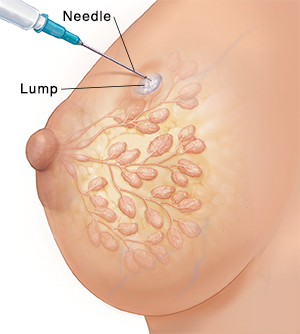Needle Breast Biopsy
A needle breast biopsy is done by putting a hollow needle through the skin of the breast. A small piece of the changed tissue (sample) is then removed for testing. This type of biopsy can be done in a healthcare provider’s office or in an outpatient setting. In some cases, a special probe is used instead of a needle. Then a tiny cut (incision) is made in the skin to put the probe into the changed breast tissue or lump. Sometimes a marker is left at the spot of the biopsy. This is helpful if surgery is needed or for monitoring the area in the future. Once removed, the biopsy sample is sent to a lab for testing.

If a lump or breast change can't be felt, an image-guided biopsy is done. The breast change is found using ultrasound, mammography, or MRI. The resulting images help your healthcare provider guide the needle to the right place. The type of breast biopsy done depends on the following:
-
The size of the lump or breast change
-
Where it is in the breast
-
Other health problems you may have
-
Your preferences
Talk with your provider about the pros and cons of the biopsy types and which one they recommend. Also talk about what you can expect during and after the biopsy.
Understanding the risks
Before the biopsy, your provider will talk with you about the risks of the procedure, such as:
-
You may have slight swelling, bruising, or bleeding where the needle or probe is put through the skin. This goes away over time.
-
There's a small risk of infection.
-
All needle biopsies may provide a false-negative result. This means you may have cancer cells that don’t show up in the biopsy sample. If this happens or the results aren’t clear, you'll likely need to have another kind of breast biopsy. Often this other biopsy will be one that removes more tissue.
During the biopsy
Needle biopsies are usually done under local anesthesia. This means medicine is used to numb the area of the breast that the needle will be put into, but you will be awake.
There are several types of needle breast biopsy procedures. The type of biopsy done will depend on the size of the breast lump or change and where it is in your breast. Here are brief descriptions of the most common types:
-
Fine needle aspiration (FNA). A very thin, hollow needle is put through your skin and into the lump. Tissue or fluid is pulled into the needle with a syringe. No cut is needed. This type of biopsy takes only a few minutes.
-
Core needle biopsy. A larger hollow needle is used to take out small cylinders or cores of tissue. Several samples are taken. The needle is put in for each sample. A spring-loaded tool called a biopsy gun may be used to move the needle in and out of the lump quickly.
-
Vacuum-assisted biopsy. A hollow, tubelike probe is put into the area of changed breast tissue. A small rotating knife inside the tube cuts loose the tissue. The tissue is gently suctioned into the probe. A small cut in the skin may be needed to put in the larger hollow probe.
When needed, any of these biopsies can be done using an imaging test to guide the needle to the area of concern.
After the biopsy
You can go home shortly after the biopsy, no matter which type is done. And you can return to your normal routine almost right away. Ask when you can return to your normal activities. You may have some bruising and swelling for a few days. Be sure you know what the signs of problems are and when to call your healthcare provider. Sometimes a small, frecklelike scar appears.
Ask your healthcare provider when you can expect your biopsy results, how you'll get them, and who will provide the results and answer your questions.